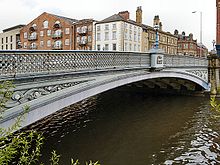Leeds Bridge
| Leeds Bridge | |
|---|---|
 |
|
| Coordinates | 53°47′38″N 1°32′30″W / 53.7939°N 1.5418°WCoordinates: 53°47′38″N 1°32′30″W / 53.7939°N 1.5418°W |
| Carries | Bridge End |
| Crosses | River Aire |
| Locale | Leeds, West Yorkshire |
| Heritage status | Grade II listed |
| Characteristics | |
| Design | arch bridge |
| Material | cast iron |
| History | |
| Opened | 1870 |
Leeds Bridge is a historic river crossing in Leeds, England. The present cast iron road bridge over the River Aire dates from 1870. It is Grade II listed.
The medieval town of Leeds centred on 13th century burgess building plots either side of a wide road from the river crossing called Bridge Gate, now Briggate. A wool cloth market operated at Leeds Bridge, becoming the centre of wool trade for the West Riding of Yorkshire in the late 17th century.
A medieval bridge was built at the site of a ferry across the River Aire. It was widened in 1730 and 1760. The bridge was rebuilt in 1870-73 by W. H. Barlow to a design by T. Dyne Steel. The iron was cast by John Butler of Stanningley. The cast iron balustrade is of rings and flowers. The east side bears the arms of the Corporation of Leeds (crowned owls and fleece). The western side has the names of civic dignitaries on a plaque.
In 1875 thousands of local inhabitants crammed onto the bridge, Briggate and local streets to watch The Theatre burning down.
Leeds Bridge marks the western terminus of the Aire and Calder Navigation which opened in 1700 creating a vital goods transportation infrastructure.
In 1888 Louis Le Prince made a pioneering moving picture recording of Traffic Crossing Leeds Bridge from an upstairs window of No 19 Bridge End, then Hicks the Ironmongers. This was shortly after making his first film Roundhay Garden Scene.
...
Wikipedia
